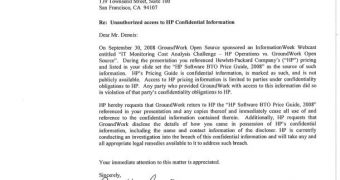According to a recent piece on CNet, leading PC maker Hewlett-Packard has sent a complaint to GroundWork, an open-source competitor, in which the Palo Alto, California-based systems maker is asking GroundWork to cease revealing HP's “confidential pricing.” The letter doesn't claim that GroundWork is using false data to promote its own product, which can only confirm that HP is well aware of the fact that its IT monitoring software product is considerably more expensive than that of its open-source competitor.
"During the presentation, you referenced the Hewlett-Packard Company's (‘HP’) pricing and listed in your slide set the ‘HP Software BTO Pricing Guide, 2008’ as the source of such information. HP's Pricing Guide is confidential information, is marked as such, and is not publicly available. Access to HP pricing information is limited to parties under confidentiality obligations to HP." the letter in question reads.
This fragment of the letter makes it clear that HP is placing its bet on the fact that the data provided by GroundWork, when presenting its own products, is confidential and should not be used publicly. However, according to CNet’s Matt Asay, HP's pricing is publicly available at GSA Advantage, which is probably where GroundWork also took the data it used for the presentation. This basically means that the purpose of HP's letter is to keep the pricing policy private because it can potentially reveal just how much users have to pay for HP's software, as opposed to that provided by GroundWork.
In a report released by GroundWork on September 17, the open-source company stressed some of the advantages of its product, which includes an "87 percent total cost savings over a three year period." "We hear first-hand from our customers that pricing per-node doesn't work in the way they need to manage their IT environments," said Dave Lilly, founder and CEO of GroundWork Open Source. "Our customers benefit not only from budgetary predictability and cost savings, but from the increased operational and deployment flexibility our subscription model allows. Monitoring mission critical services, applications, and infrastructure is itself mission-critical. Charging for it by the node is like charging a toll to rescue workers crossing a bridge to put out a fire."

 14 DAY TRIAL //
14 DAY TRIAL //